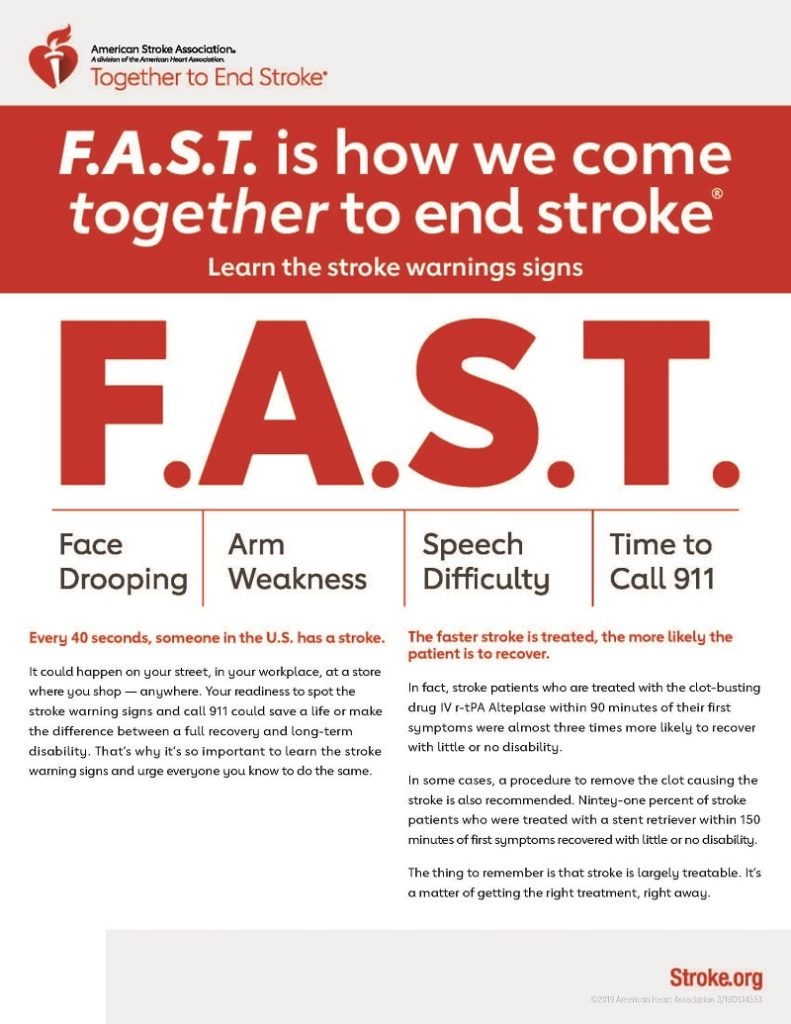How to Spot Signs of an Oncoming Stroke
Chest Pain & Heart Attack
•
May 12, 2021

Stroke is the 5th leading cause of death in the country, so knowing how to spot signs of an oncoming stroke can save your or a loved one’s life. This article teaches techniques such as the Be FAST stroke assessment for spotting an oncoming stroke and what steps to take when an emergency does strike.
Some of the signs of a stroke discussed in this article are similar to those of a seizure. To better distinguish between a stroke vs. a seizure, read our blog for more information.
What causes a stroke?
A stroke occurs when there is a disruption of blood flow to the brain causing the brain cells to die. According to the American Heart Association, 1 in 19 people died from a stroke in the United States in 2018, making strokes a dangerous medical emergency to be taken seriously.
There are two types of strokes: ischemic strokes and hemorrhagic strokes. An ischemic stroke, the most common type of stroke, is caused by a lack of blood flow to the brain due to a clot or blockage in the blood vessels.
A hemorrhagic stroke is caused by an accumulation of blood in the skull. As a result, the affected area of the brain will no longer function properly, which can lead to a loss of bodily function. If not treated immediately, your brain can suffer irreversible damage.
Though strokes commonly affect the elderly, anyone of any age can have a stroke. Factors like your family’s health history and your own health habits can put you at higher risk for having a stroke.
The faster you treat or take steps to avoid a stroke, the better your chances of being able to maintain a functional lifestyle.
What are the symptoms of pre-stroke?
A pre-stroke, also known as transient ischemic attacks (TIA), occurs when there is a temporary clot or brief lack of blood flow to the brain. The symptoms of a pre-stroke are very similar to those of a regular stroke –– numbness, slurred speech, dizziness, headaches –– but typically resolve after 24 hours.
However, because TIAs are one of the most common early signs of stroke, they deserve immediate medical attention. According to the American Stroke Association, about 9-17% of patients who have a TIA have a stroke within 90 days. Other sources state that symptoms can show up as early as seven days before the stroke occurs. Regardless, with strokes, time is always of the essence, so don’t delay seeking medical help.
Those who are more at risk for having a TIA are those who have a cardiovascular disease, diabetes, or those who smoke. The key to preventing a pre-stroke is to live a heart-healthy lifestyle:
- Eat healthier and stay active
- Monitor your blood pressure
- Quit smoking
Spot signs using the Be FAST stroke assessment
One technique used to spot the more well-known warning signs of stroke is referred to as the Be FAST stroke assessment. This involves asking the affected person to perform a short series of actions with simple questions to see if they may be suffering from a stroke. Remember, you have to act FAST:
F– Face is starting to droop downwards: Ask the person to smile and see if one side looks uneven.
A – Arm feels weak with inability to move it: Ask the person to raise both arms and see if one side feels weaker than the other.
S– Speech difficulty or slurring of words: Ask the person to speak a simple sentence and check for any slurring or difficulty pronouncing words.
T– Time to call 911: If any situations above occur, dial 911 immediately.

Additional signs of an oncoming stroke
There are other signs of an oncoming stroke to be aware of beyond FAST:
- Numbness on one side of the body
- Confusion with understanding speech or speaking
- Trouble walking or keeping balance
- Severe headaches with no cause
As mentioned above, if you notice any of these symptoms call 911 immediately or locate your nearest emergency room. A free-standing emergency room is often able to see the patient in a more timely manner than a hospital-based emergency room.
Deciding between the ER and urgent care? Visit our website to learn about the difference between urgent care and ER.
Visit a Complete Care ER Immediately if You Spot the Signs of an Oncoming Stroke
Now that you have a better grasp on the signs of an oncoming stroke, Complete Care is here to help you or a loved one treat their stroke* symptoms fast. Our 24 hr emergency walk-in clinic locations are fully equipped with hospital-grade medical staff and technology to treat any emergency at any time.
We have ER locations in both Texas and Colorado. To hear why actual patients love our emergency services, peruse through real patients’ Complete Care testimonials. Whether you have an emergency or just a simple health question, we will take complete care of you.
*Please note that Complete Care does not carry the medication (TPA) used in stroke treatment. We can diagnose patients who have had a stroke and send them on to a stroke center hospital but do not encourage choosing a free-standing emergency room over a hospital in stroke emergencies.
More Helpful Articles by Complete Care: